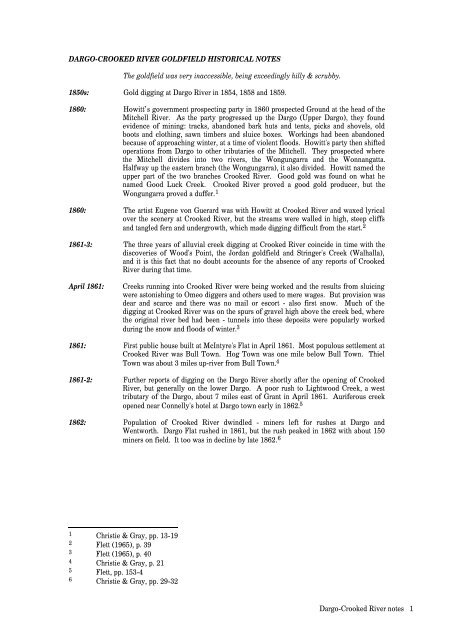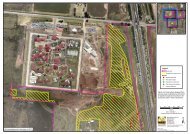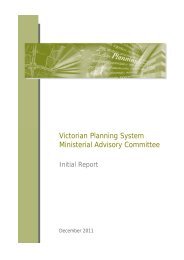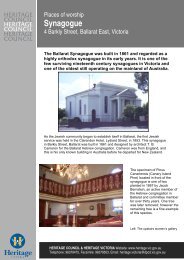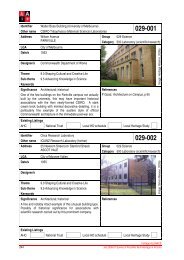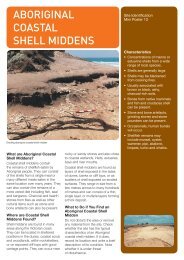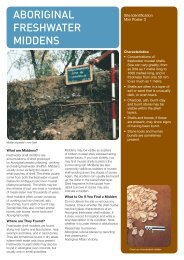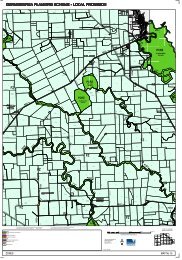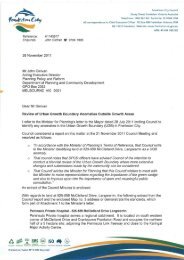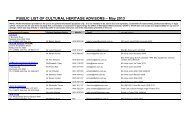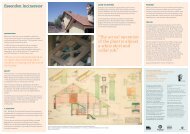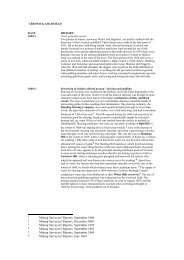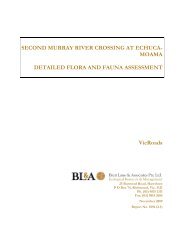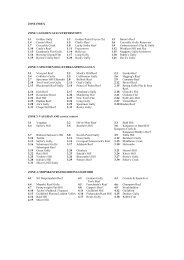Dargo-crooked river goldfield historical notes - Department of ...
Dargo-crooked river goldfield historical notes - Department of ...
Dargo-crooked river goldfield historical notes - Department of ...
You also want an ePaper? Increase the reach of your titles
YUMPU automatically turns print PDFs into web optimized ePapers that Google loves.
DARGO-CROOKED RIVER GOLDFIELD HISTORICAL NOTES<br />
The <strong>goldfield</strong> was very inaccessible, being exceedingly hilly & scrubby.<br />
1850s: Gold digging at <strong>Dargo</strong> River in 1854, 1858 and 1859.<br />
1860: Howitt’s government prospecting party in 1860 prospected Ground at the head <strong>of</strong> the<br />
Mitchell River. As the party progressed up the <strong>Dargo</strong> (Upper <strong>Dargo</strong>), they found<br />
evidence <strong>of</strong> mining: tracks, abandoned bark huts and tents, picks and shovels, old<br />
boots and clothing, sawn timbers and sluice boxes. Workings had been abandoned<br />
because <strong>of</strong> approaching winter, at a time <strong>of</strong> violent floods. Howitt's party then shifted<br />
operations from <strong>Dargo</strong> to other tributaries <strong>of</strong> the Mitchell. They prospected where<br />
the Mitchell divides into two <strong>river</strong>s, the Wongungarra and the Wonnangatta.<br />
Halfway up the eastern branch (the Wongungarra), it also divided. Howitt named the<br />
upper part <strong>of</strong> the two branches Crooked River. Good gold was found on what he<br />
named Good Luck Creek. Crooked River proved a good gold producer, but the<br />
Wongungarra proved a duffer. 1<br />
1860: The artist Eugene von Guerard was with Howitt at Crooked River and waxed lyrical<br />
over the scenery at Crooked River, but the streams were walled in high, steep cliffs<br />
and tangled fern and undergrowth, which made digging difficult from the start. 2<br />
1861-3: The three years <strong>of</strong> alluvial creek digging at Crooked River coincide in time with the<br />
discoveries <strong>of</strong> Wood's Point, the Jordan <strong>goldfield</strong> and Stringer's Creek (Walhalla),<br />
and it is this fact that no doubt accounts for the absence <strong>of</strong> any reports <strong>of</strong> Crooked<br />
River during that time.<br />
April 1861: Creeks running into Crooked River were being worked and the results from sluicing<br />
were astonishing to Omeo diggers and others used to mere wages. But provision was<br />
dear and scarce and there was no mail or escort - also first snow. Much <strong>of</strong> the<br />
digging at Crooked River was on the spurs <strong>of</strong> gravel high above the creek bed, where<br />
the original <strong>river</strong> bed had been - tunnels into these deposits were popularly worked<br />
during the snow and floods <strong>of</strong> winter. 3<br />
1861: First public house built at McIntyre's Flat in April 1861. Most populous settlement at<br />
Crooked River was Bull Town. Hog Town was one mile below Bull Town. Thiel<br />
Town was about 3 miles up-<strong>river</strong> from Bull Town. 4<br />
1861-2: Further reports <strong>of</strong> digging on the <strong>Dargo</strong> River shortly after the opening <strong>of</strong> Crooked<br />
River, but generally on the lower <strong>Dargo</strong>. A poor rush to Lightwood Creek, a west<br />
tributary <strong>of</strong> the <strong>Dargo</strong>, about 7 miles east <strong>of</strong> Grant in April 1861. Auriferous creek<br />
opened near Connelly's hotel at <strong>Dargo</strong> town early in 1862. 5<br />
1862: Population <strong>of</strong> Crooked River dwindled - miners left for rushes at <strong>Dargo</strong> and<br />
Wentworth. <strong>Dargo</strong> Flat rushed in 1861, but the rush peaked in 1862 with about 150<br />
miners on field. It too was in decline by late 1862. 6<br />
1 Christie & Gray, pp. 13-19<br />
2 Flett (1965), p. 39<br />
3 Flett (1965), p. 40<br />
4 Christie & Gray, p. 21<br />
5 Flett, pp. 153-4<br />
6 Christie & Gray, pp. 29-32<br />
<strong>Dargo</strong>-Crooked River <strong>notes</strong> 1
December 1862: Lower portion <strong>of</strong> Crooked River being re-worked - pays about £4/week per man.<br />
Wongongarri (Wongungarra) River prospected for 40 miles - payable nearly all the<br />
way. Lightwood Creek, on the <strong>Dargo</strong> - good prospects obtained - party has gone to<br />
open it. 7<br />
January 1863: Crooked River sinkings continue to support small popn, earning about £4-6/week per<br />
man. 8<br />
May 1863: 200-300 miners making wages from Crooked River country. 9<br />
1863: In February the <strong>Dargo</strong> diggings were said to be equal to anything in Gippsland. Later<br />
that year a series <strong>of</strong> rushes began to the upper branches <strong>of</strong> the <strong>Dargo</strong> and Crooked<br />
<strong>river</strong>s prospected by parties from Bright in winter <strong>of</strong> 1863 - Bloomfield's Rush,<br />
between Mounts Tabletop and Smythe - Bloomfield (prospector) lost in snow - also<br />
Rusch's Rush. By October, 8 miles <strong>of</strong> the <strong>Dargo</strong> was occupied by 400 men, 'in view<br />
<strong>of</strong> Tabletop'. 10<br />
1863: Gold discovered in September at head <strong>of</strong> <strong>Dargo</strong> River (Upper <strong>Dargo</strong> Diggings –<br />
Bloomfield's Rush), 15 miles above the crossing to Crooked River and about 7 or 8<br />
miles above old workings (Pikes Creek) visited by Howitt in 1860. By December,<br />
350-400 miners were spread along some 8 miles <strong>of</strong> the <strong>river</strong>, working with pumps,<br />
wheels and sluice boxes and averaging about 100 oz/week. 11<br />
October 1863: It is probable that a considerable rush will set in to the <strong>Dargo</strong> in the course <strong>of</strong> a few<br />
weeks; all those parties who have lately come in [to Bright] agree in stating the<br />
prospects are exceedingly good, and that there are several miles <strong>of</strong> ground on that<br />
<strong>river</strong> equally likely to prove payable. 12<br />
1863-4: Chief rush to the <strong>Dargo</strong> River was in summer 1863-4, when Mayford started as<br />
centre for the alluvial diggings, and Pikes Creek was worked. Other rushes to 18-<br />
Mile Creek and to Twenty-five Mile or Joy's Creek, coming down from <strong>Dargo</strong> High<br />
Plains, which was rushed by 'Italians, Austrians, and Selavonians.' 13<br />
1863-4: The main gold rushes on the <strong>Dargo</strong> were in April 1863 and again in April 1864. 14<br />
March 1864: Mining population: <strong>Dargo</strong> River, 60; Crooked River, 220. <strong>Dargo</strong> River now being<br />
abandoned for the season, most <strong>of</strong> the ground not <strong>of</strong>fering sufficient inducement to<br />
miners to undergo the great expense and hardship <strong>of</strong> wintering there. Several have<br />
left for the Crooked River - workings now hold out greater inducements than those on<br />
the <strong>Dargo</strong> - greater extent <strong>of</strong> more open country, which has also the important<br />
advantage <strong>of</strong> being accessible from the Gipps Land settlements. 15<br />
1864: Miners getting poor returns from the <strong>river</strong> on Upper <strong>Dargo</strong> Diggings - main deposit<br />
<strong>of</strong> gold not in bed <strong>of</strong> <strong>river</strong>, but on spur - working it will require water races from<br />
tributaries <strong>of</strong> <strong>Dargo</strong> River. 16<br />
1864: In the spring <strong>of</strong> 1864, the upper tributaries <strong>of</strong> the Crooked River, the 30 Mile Creek<br />
that touched on the new road to the <strong>Dargo</strong> and Morses at Little Woman’s, had been<br />
7 Mining Surveyors' Reports (Gipps land Division), December 1862<br />
8 Mining Surveyors' Reports (Gipps land Division), January 1863<br />
9 Mining Surveyors' Reports (Gipps land Division), May 1863<br />
10 Flett, pp. 154-5<br />
11 Christie & Gray, pp. 33-7<br />
12 Mining Surveyors' Reports (Buckland Division), October 1863<br />
13 Flett, p. 155<br />
14 Flett (1965), p. 44<br />
15 Mining Surveyors' Reports (Buckland Division), March 1864<br />
16 Christie & Gray, p. 37<br />
<strong>Dargo</strong>-Crooked River <strong>notes</strong> 2
ushed in its upper reaches, to the west <strong>of</strong> the <strong>Dargo</strong> High Plains, and the east<br />
tributary <strong>of</strong> the Crooked, Joy's or 25 Mile Creek also. 17<br />
1864: Prospecting tracks cut by government Alpine Expedition, led by Angus McMillan -<br />
track to Crooked River from Connelly's Inn (Quackmunjie), dray track over ranges<br />
dividing <strong>Dargo</strong> and Crooked <strong>river</strong>s, and track between Omeo and Crooked River.<br />
While cutting the dray track over the ranges between the two <strong>river</strong>s, road cutters<br />
discovered a quartz reef on the north side <strong>of</strong> the Wongungarra River opposite the<br />
later surveyed township <strong>of</strong> Howittville - the reef was named Pioneer, after the finder's<br />
favourite horse. Most <strong>of</strong> the track-cutting party deserted and commenced<br />
prospecting, and 15 claims were quickly marked out in the vicinity. (One <strong>of</strong> the<br />
reef's discoverers was an N. Jorgensen - according to Flett, 'a Stratford prospector' -<br />
would have been one <strong>of</strong> the Jorgensen brothers who worked the Freestone-Gladstone<br />
Creek area from the 1870s.) Soon (1865) the Union Reef was discovered, and other<br />
claims with rich shows <strong>of</strong> surface gold included Matheson's, the Jolly Sailor, Italian,<br />
and Aberdeen. 18<br />
June 1864: During the last quarter several highly auriferous reefs have been discovered on the<br />
Crooked River, which bid fair to equal anything every discovered in the division.<br />
The 'Pioneer', the 'Jeff Davis' and the 'Goodluck' reefs on Goodluck Creek and the<br />
'Oriental' and 'Golden Bar' reefs, situated nearly opposite the junction <strong>of</strong> the<br />
Goodluck Creek and the Crooked River. About 150 diggers on reefs. 19<br />
1864: First reefs discovered after the Pioneer were the Jeff Davis, the Good Luck, and the<br />
Glengarry at the head <strong>of</strong> Jungle Creek. 20<br />
1864: Population <strong>of</strong> Crooked River increased and Bull Town became a central gathering<br />
place. Bull Town was six miles from the Pioneer Reef, so a settlement was formed<br />
across the Crooked River, to the south <strong>of</strong> the reef - originally called Ram Town, its<br />
name was soon changed to Talbotville. Three miles down<strong>river</strong>, on the Wongungarra,<br />
was the small village <strong>of</strong> Rathmines (also known as Little London & Winchester).<br />
The settlement at Good Luck Creek was called Stonewall (after Confederate hero,<br />
General Stonewall Jackson) - at the foot <strong>of</strong> Jeff Davis Spur, about one mile from Jeff<br />
Davis Reef, on junction <strong>of</strong> Good Luck Creek and Crooked River. Away from the<br />
<strong>river</strong>, at Isaac's Shanty on Mt Pleasant, another town was growing - after only 3<br />
months, it was clear that this town would outstrip the rest - known variously as Isaac's<br />
Town, Skye, and Mt Pleasant - later became Grant. 21<br />
17 Flett (1965), p. 44<br />
18 Christie & Gray, pp. 36-8; Flett (1965), p. 40<br />
19 Mining Surveyors' Reports (Crooked River Subdivision), June 1864<br />
20 Flett, p. 152<br />
21 Christie & Gray, pp. 43-7, 51; Flett (1965), p. 40<br />
<strong>Dargo</strong>-Crooked River <strong>notes</strong> 3
1864: Crooked River reef discovery ushered in such a period <strong>of</strong> reef discovery as to be<br />
without parallel in Victoria, and by the end <strong>of</strong> 1864, 457 diggers were working on<br />
180 claims on 92 separate reefs. 21 <strong>of</strong> these were on Mt Pleasant, 28 were in Jungle<br />
Creek basin to the south, 15 were north-west in vicinity <strong>of</strong> Goodluck Creek, 9 on<br />
Crooked River, 5 on Spring Hill (about 3 miles SE on Stratford Road), 5 on<br />
Wonnangatta River, and 4 on Good Hope spur, about halfway to Talbotville. With<br />
the warmer weather in the late spring <strong>of</strong> 1864 the real influx into Crooked River<br />
occurred - over 500 alluvial diggers - gullies worked nearby newly discovered reefs.<br />
Tracks to <strong>Dargo</strong> and Stratford opened - horse and bullock teams arriving with<br />
supplies by October 1864. By December, Pioneer and Jeff Davis mining plants on<br />
ground, and plants for main Mt Pleasant reefs (Little Dorritt, Union and Moonlight<br />
Cos) on way. 22<br />
1864: By December 1864, 91 distinct quartz reefs had been proved auriferous, 180 quartz<br />
prospecting claims were registered, a mining registrar/surveyor was appointed, and<br />
there were an estimated 370 quartz miners on the Wongungarra, Wunnangatta, Jungle<br />
Creek, Crooked River, <strong>Dargo</strong>, Mt Pleasant, Good Hope, Good Luck, and Spring Hill.<br />
The Pioneer Co. was employing 50 men, and Jeff Davis Co. 35 men, but most mines<br />
were small operations, employing less than 5 men. 23<br />
December 1864: Continued reports <strong>of</strong> discoveries <strong>of</strong> rich reefs have caused a large influx <strong>of</strong><br />
population – 'perhaps greater than is warranted until such time as quartz crushing<br />
machines have been erected on the reefs'. Mining population on Upper <strong>Dargo</strong> River,<br />
250 - principally Chinese. Kitchingham & Co. will shortly have their Balfour's<br />
patent crusher working for the Jolly Sailors QMC. Pioneer and Jeff Davis reefs<br />
already have crushing plant on ground – Union, Moonlight and Little Dorrit reefs<br />
awaiting plant - also Victoria Co. and Hartley and Co., awaiting batteries to crush for<br />
all reefs in Upper and Lower Jungle Creek – Good Hope Co. will erect battery on<br />
creek, to crush for Collingwood and Uncle Tom reefs as well as their own - Hibernia<br />
party to erect machine at bottom <strong>of</strong> Hibernia Spur, to crush their own stone and that<br />
from Brother Jonathan, Malvern Hill, and Rose and Shamrock claims. Alluvial<br />
diggings in all the workings appear to be <strong>of</strong> a very patchy character - bank and spur<br />
claims along Crooked River pay the best. Chinese confined to Upper <strong>Dargo</strong><br />
diggings, except a few who are gardeners or domestic servants on Crooked River or<br />
Mt Pleasant. Youngson and Co. plan to divert the Warrangarra River into the flat<br />
opposite the Pioneer Reef - intend to work <strong>river</strong> bed and afterwards the entire flat -<br />
first attempt by capitalists to thoroughly prospect Warrangarra River. The country<br />
actually worked extended from lower end <strong>of</strong> Jungle Creek to Upper <strong>Dargo</strong> River,<br />
distance <strong>of</strong> 30 miles, and from Bulltown, on Crooked River, to the Wentworth, a<br />
distance <strong>of</strong> 60 miles. 24<br />
December 1864: Many Chinese who had left Harrietville for the <strong>Dargo</strong> are beginning to return - old<br />
workings more pr<strong>of</strong>itable than the <strong>Dargo</strong>. 25<br />
mid-1860s: Key production period. The first crushings <strong>of</strong> the Pioneer Co. produced 15,000 oz/30<br />
tons. Jeff Davis and Pioneer companies were originally seen as the major operators,<br />
but both ceased operations within a year. Their machines were then leased out. 26<br />
1864-77: Only reef at Grant that showed any permanence was the Good Hope Mine, that began<br />
in 1864 and was worked from four tunnels on the east side <strong>of</strong> the spur. In 1868, it<br />
produced 6,912 oz <strong>of</strong> gold and to 1877 nearly 20,000 oz. 27<br />
March 1865: Companies (except Union claim) refuse to give results <strong>of</strong> crushings. Pioneer battery<br />
spur wheel broke before more than a few tons could be crushed, and even this<br />
22 Flett (1965) p. 40<br />
23 Christie & Gray, pp. 70-71<br />
24 Mining Surveyors' Reports (Crooked River Subdivision), December 1864<br />
25 Mining Surveyors' Reports (Buckland Division), December 1864<br />
26 Christie & Gray, p. 77<br />
27 Flett (1865), p. 42<br />
<strong>Dargo</strong>-Crooked River <strong>notes</strong> 4
quantity has not been retorted. 22_ miles <strong>of</strong> water races in subdivision - large amount<br />
<strong>of</strong> fluming necessary, due to irregularities <strong>of</strong> ground. Crooked River in Beechworth<br />
Mining District. 28<br />
June 1865: Mining population: 374 alluvial (120 Chinese), 868 quartz miners. Batteries for Jolly<br />
Sailors, Good Hope, Globe, and Hartley's on ground. Three new reefs discovered at<br />
Upper <strong>Dargo</strong> River - specimens equal in richness to anything yet produced in district.<br />
Assistance <strong>of</strong> capitalists required in district - want <strong>of</strong> capital prevents proper<br />
development <strong>of</strong> reefs - large number <strong>of</strong> suspensions <strong>of</strong> claims due to lack <strong>of</strong> funds. 29<br />
September 1865:Mining population: 395 alluvial (112 Chinese), 450 quartz miners. 257 distinct quartz<br />
reefs proved auriferous. Pioneer and Jeff Davis companies refuse to divulge crushing<br />
results - no escort (returns) and bank will not give details <strong>of</strong> gold deposits. 'These<br />
reefs are the principal support <strong>of</strong> the place and yield the largest quantities <strong>of</strong> gold, so<br />
that unless their correct returns be made public the real value <strong>of</strong> the reefs may be<br />
underrated.' Pioneer and Jeff Davis companies' batteries cost £2,637 and £3,500<br />
respectively. Yields from Victoria Reef remarkably poor - alterations made to<br />
machinery. Mornington battery situated immediately beside Jolly Sailor's claim<br />
(mining operations now suspended). Teutonia Co. erecting portable battery<br />
immediately below their claim. Eureka to erect battery on claim at Upper <strong>Dargo</strong> -<br />
battery ex Morse's Creek. Water races - 25 constructed, all less than a mile in length.<br />
'The Crooked River has lost its attraction for speculators, and numbers <strong>of</strong> miners who<br />
tried their utmost and hold on to reefs, with the hope <strong>of</strong> selling out at high prices,<br />
have been necessitated to abandon them and leave the district.' Out <strong>of</strong> more than 125<br />
gold mining leases taken up and surveyed there are not 20 worked. Tunnelling<br />
claims <strong>of</strong> 66 acres pegged <strong>of</strong>f in every direction - very little bona fide work carried<br />
on. One third <strong>of</strong> population has left for NZ and elsewhere - more would have<br />
deserted field, but that a tributary <strong>of</strong> Good Luck Creek is giving good yields to a<br />
considerable number <strong>of</strong> alluvial diggers. Of 257 reefs, only 50 now actually worked -<br />
remainder either suspended for want <strong>of</strong> funds or totally abandoned. 30<br />
September 1865: Good Hope Co. erected 12-head battery. 31<br />
December 1865: 27 new reefs discovered during quarter, more than half <strong>of</strong> them on Upper <strong>Dargo</strong> -<br />
now 280 reefs in all. Eureka Co., Upper <strong>Dargo</strong> erecting 8-head battery - 12-hp<br />
waterwheel. Britannia and Eldorado Co. erecting 8-head, 12-hp battery. New<br />
America claim erecting 8-head battery, powered by turbine wheel <strong>of</strong> 32 hp. Jungle<br />
and Globe batteries completed. 32<br />
1865+: Union Co. was one <strong>of</strong> the longest-lived <strong>of</strong> the Crooked River mines. Located half a<br />
mile from Grant. Tunnel driven 250 ft before reef was struck. Mine still operating at<br />
turn <strong>of</strong> century. Name changed to Sons <strong>of</strong> Freedom in 1877, then reverted to<br />
Union. 33<br />
28 Mining Surveyors' Reports (Crooked River Subdivision), March 1865<br />
29 Mining Surveyors' Reports (Crooked River Subdivision), June 1865<br />
30 Mining Surveyors' Reports (Crooked River Subdivision), September 1865<br />
31 Christie, p. 23<br />
32 Mining Surveyors' Reports (Crooked River Subdivision), December 1865<br />
33 Christie & Gray, p. 77<br />
<strong>Dargo</strong>-Crooked River <strong>notes</strong> 5
1865+: Expectations have hardly ever been less realised than they were in the Grant reefs. In<br />
first 3 months <strong>of</strong> 1865, digging population <strong>of</strong> Crooked River rose to 1,270 - <strong>of</strong> those<br />
786 were on the reefs and prospecting for others - population <strong>of</strong> Grant about 500 - Mt<br />
Pleasant was transformed from the savage, heavily timbered mountain top to the<br />
habitation <strong>of</strong> man. Early rich yields from a great number <strong>of</strong> reefs justified optimism:<br />
Pioneer got 5 oz/ton, Jeff Davis nearly 5 oz/ton, and many others over 1 oz/ton.<br />
Early in 1865, 203 reefs were declared. Grant township surveyed in April 1865, sold<br />
in August – 18 hotels, and 16 on road to Stratford - also great number <strong>of</strong> restaurants<br />
and Australia's first beer garden, frequented by Italian diggers. The first rich yields<br />
from reefs were generally injudiciously spent or else on the first discovery a company<br />
was formed and the reef sold to speculators. The main 'rush' to Crooked River<br />
produced only about 5,000 oz <strong>of</strong> gold and by the following year only about 15 reefs<br />
were working. Of 125 leases taken out by September 1865 only 20 had been worked<br />
and the rest were forfeited in 1866. 34<br />
1865-1915: Good Hope mine was longest-worked mine at Crooked River. Worked from 5<br />
tunnels. Best years were 1865-70. Original Good Hope Co. closed down after 12 yrs<br />
- paid dividends <strong>of</strong> £27,000. Became New Good Hope Co. in 1879. Total yield<br />
20,360 oz from 12,769 tons. Located on west side <strong>of</strong> leading spur on top <strong>of</strong> which<br />
runs the main road from Crooked River to Stratford. 35<br />
1865-6: First crushing machine (Union Reef - steam-powered) commenced work - soon after<br />
came Pioneer and Jeff Davis batteries (both water-powered). Also public crushing<br />
works, operated by Victoria Co. and Hartley & Co. (both steam-powered), crushing<br />
for all reefs in upper and lower Jungle Creek. Good Hope Co. - 12-head battery<br />
(steam-powered - portable steam engine soon replaced by 15 hp horizontal engine)<br />
erected to crush from Good Hope, Uncle Tom, and Collingwood reefs - also Chilean<br />
mill and furnace for treating pyrites. Hibernia Co. battery erected at bottom <strong>of</strong><br />
Hibernia Spur, to crush from Brother Jonathan, Great Western, Malvern Hill, and<br />
Rose and Shamrock reefs - also tramway. Jolly Sailor battery was steam-powered.<br />
By end <strong>of</strong> 1865, 8 batteries on field. By end <strong>of</strong> 1865, many quartz claims were<br />
abandoned due to the cost/distance <strong>of</strong> carting to batteries, as well as lack <strong>of</strong> funds,<br />
and speculation by city capitalists, which led to extensive shepherding, discouraging<br />
bona fide miners. 36<br />
March 1866: Mining population: 230 alluvial (84 Chinese), 518 quartz miners. 5 steam batteries, 3<br />
water-powered. General depression throughout the district, due to the improvident<br />
speculation begun six or eight months ago - most claims worked by bona fide miners<br />
have proved as good or better than expected - but many claims shepherded by<br />
speculators. 'Unfortunately, the reckless and unpr<strong>of</strong>itable manner in which capital<br />
was invested and wasted in the subdivision in its earlier days must, undoubtedly, for a<br />
long time, militate against its development'. Fifteen new reefs discovered during<br />
quarter - 10 in vicinity <strong>of</strong> Grant, five on Upper <strong>Dargo</strong>. Good-looking Upper <strong>Dargo</strong><br />
reefs include the California (sample crushing by hand), Morning Star (erecting<br />
battery), Evening Star, John Conness, and <strong>Dargo</strong> Hope – last-named two are richest -<br />
also Eureka Reef and Ophir Reef (continuation <strong>of</strong> Eureka). Good Hope Co. - shaft<br />
down 240 ft - quartz getting richer the deeper they sink – machinery and furnace<br />
being erected to separate gold from pyrites. Union Co. engaged driving very long<br />
tunnel. Hibernia Co. about to erect battery and tramway at cost <strong>of</strong> £4,000. Jeff Davis<br />
and Pioneer reefs still suppressing details <strong>of</strong> crushings. 37<br />
1866: New reefs discovered on Upper <strong>Dargo</strong> field. First battery erected on Eureka claim -<br />
8-head, water-powered - initial crushings gave 400 oz from 100 tons. Morning Star<br />
Co. and Cornish claim also erected batteries. Some batteries brought from Crooked<br />
River field, eg. Evening Star, Upper <strong>Dargo</strong> (ex Union battery). 38<br />
34 Flett (1965), pp. 40-2<br />
35 Christie & Gray, pp. 80-85<br />
36 Christie & Gray, pp. 72-6, 80<br />
37 Mining Surveyors' Reports (Crooked River Subdivision), March 1866<br />
38 Christie & Gray, pp. 86-7<br />
<strong>Dargo</strong>-Crooked River <strong>notes</strong> 6
June 1866: Mining population: 160 alluvial (60 Chinese), 565 quartz miners - most working on<br />
reefs at Upper <strong>Dargo</strong> (200) and Mt Pleasant (175). Nearly £10,000 worth <strong>of</strong> gold<br />
taken out <strong>of</strong> Good Hope Co. claim in last six months, one-half <strong>of</strong> which has paid all<br />
working expenses. Work suspended on Union and Jeff Davis claims. New reefs<br />
include the Frank Walsh and St Leger. 39<br />
September 1866:Mining population: 277 alluvial (113 Chinese), 389 quartz miners. Small rush (100<br />
men, mainly Chinese) to Wentworth River. Decrease in quartz miners - some<br />
working instead on alluvial at Good Luck Creek. Work suspended on several reefs at<br />
Grant - high cost <strong>of</strong> cartage (35s per ton) and crushing (25s per ton) - reefs not rich or<br />
extensive enough to pay for working - very few exceed 8 inches in width. 40<br />
December 1866:Mining population: 511 alluvial (257 Chinese), 297 quartz miners. 270 miners<br />
(mainly Chinese) at Wentworth River, 211 at Upper <strong>Dargo</strong> - only 80 at Mt Pleasant.<br />
Wentworth River and branches - 25-Mile, 30-Mile, and 35-Mile creeks. Good Hope<br />
Co. tunnelling - in about 580 ft. John Conness Co., Upper <strong>Dargo</strong>, erected 8-head<br />
battery. Evening Star Co., Upper <strong>Dargo</strong>, purchased Union Co.'s battery - removing<br />
and re-erecting it. Jeff Davis mine on tribute. 41<br />
1866-8: In 1866, sixteen reefs at Crooked River produced 7232 oz <strong>of</strong> gold - similar returns<br />
continued in 1867-8, but diminished thereafter. Grant township slowly<br />
disintegrated. 42<br />
March 1867: Small rush <strong>of</strong> alluvial miners (about 45) to old workings on Upper Crooked River. 43<br />
June 1867: Several abandoned reefs taken up again - renamed, eg. ex Bird-in-Hand now Rubble<br />
Reef, ex Kennedy's now Vulcan Reef, ex Belfast now Advance Reef - new workings<br />
yielding well and spurring on others. Kong Meng Co. started work on ex Black<br />
Snake and Gipsy Queen claims at Black Snake Creek. Most Chinese miners left<br />
Wentworth River for Boggy Creek diggings. Good Hope Co. treating quartz tailings<br />
and pyrites. 44<br />
September 1867: Kong Meng Co. erected 4-head battery. 45<br />
1867+: Kong Meng Co. formed to work Black Snake Reef on Black Snake Creek, about<br />
three miles from junction with Worrangatta River and eight miles from township <strong>of</strong><br />
<strong>Dargo</strong>. Worked mine for about three years, reputedly crushing 600 tons <strong>of</strong> quartz for<br />
an average <strong>of</strong> over 1 oz/ton. Mine then lay idle for a number <strong>of</strong> years until it was<br />
taken up by a syndicate and a lower tunnel driven along line for about 150 ft, without<br />
success. 46<br />
December 1867: Homeward-bound Co., Upper <strong>Dargo</strong>, purchased Eureka battery - erecting it near their<br />
reef. 47<br />
March 1868: Pyrites from Good Hope mine exceedingly rich - 1 ton yielded over 95 oz gold.<br />
Pioneer Co. again working their claim. Jeff Davis, Britannia and Morning Star<br />
batteries all idle. 48<br />
39 Mining Surveyors' Reports (Crooked River Subdivision), June 1866<br />
40 Mining Surveyors' Reports (Crooked River Subdivision), September 1866<br />
41 Mining Surveyors' Reports (Crooked River Subdivision), December 1866<br />
42 Flett, p. 153<br />
43 Mining Surveyors' Reports (Crooked River Subdivision), March 1867<br />
44 Mining Surveyors' Reports (Crooked River Subdivision), June 1867<br />
45 Mining Surveyors' Reports (Crooked River Subdivision), September 1867<br />
46 Kenny (1925)<br />
47 Mining Surveyors' Reports (Crooked River Subdivision), December 1867<br />
48 Mining Surveyors' Reports (Crooked River Subdivision), March 1868<br />
<strong>Dargo</strong>-Crooked River <strong>notes</strong> 7
June 1868: Hibernia Co. abandoned claim - insufficient water for crushing - intends to remove<br />
battery to another part <strong>of</strong> the field. Good Hope Co. - 12 tons <strong>of</strong> pyrites yielded 485<br />
oz - saved by means <strong>of</strong> percussion tables. John Conness Co., Upper <strong>Dargo</strong>,<br />
abandoning reef – propose moving battery to Grant vicinity. 49<br />
September 1868:Mining population reduced by one-fifth - Gibbo and Freestone rushes. Good Hope<br />
mine nearly worked out at present level. Alluvial mining almost entirely confined to<br />
25- and 30-Mile creeks. 50<br />
December 1868: Drought - only Jeff Davis and Pioneer (steam) batteries operating - Kong Meng,<br />
Crinoline, Hibernia, Jungle, Mornington, Britannia, and Globe mills (water-powered)<br />
idle. Good Hope Co. driving lower tunnel through hard rock - in 400 ft - acquiring<br />
boring machine from Sandhurst. 51<br />
March 1869: Warsaw Co. erected new battery at Upper <strong>Dargo</strong>. Alluvial mining population and<br />
yield increasing. Payable alluvial gold discovered on <strong>Dargo</strong> Flat, some 15 miles from<br />
Grant. 52<br />
June 1869: Bengal Reef Co. purchased Britannia battery and mine. Only batteries operating on<br />
Upper <strong>Dargo</strong> are Evening Star and Warsaw. Morning Star mine and mill sold and<br />
now operating as Rossbrin Mining Co. 53<br />
September 1869:Good Hope lower tunnel abandoned - rock too hard - chamber being cut in No. 3 level<br />
for pumping and winding engine. Quantity <strong>of</strong> quartz crushed lower than during any<br />
quarter since 1865 - MS hopeful <strong>of</strong> a 'turn for the better'. Batteries formerly situated<br />
so as to be 'totally unavailable for any <strong>of</strong> the mines <strong>of</strong> a permanent character' - now<br />
four formerly idle batteries have changed hands and will again be operational to<br />
'systematically work several <strong>of</strong> the most promising lodes'. Alluvial miners shifting<br />
attention to Crooked and Lower <strong>Dargo</strong> <strong>river</strong>s - workings on Crooked River formerly<br />
confined almost entirely to bed <strong>of</strong> <strong>river</strong> - several parties now working large flats<br />
extending along banks - good results - Lower <strong>Dargo</strong> miners principally Chinese. 54<br />
1869: Crooked River reefs produced 4,000-5,000 oz gold yearly, but always by new<br />
companies starting up - the yield then fell alarmingly. 55<br />
1870s-80s: Only good performer during this period was Good Hope mine. 56<br />
49 Mining Surveyors' Reports (Crooked River Subdivision), June 1868<br />
50 Mining Surveyors' Reports (Crooked River Subdivision), September 1868<br />
51 Mining Surveyors' Reports (Crooked River Subdivision), December 1868<br />
52 Mining Surveyors' Reports (Crooked River Subdivision), March 1869<br />
53 Mining Surveyors' Reports (Crooked River Subdivision), June 1869<br />
54 Mining Surveyors' Reports (Crooked River Subdivision), September 1869<br />
55 Flett (1965), p. 42<br />
56 Christie & Gray, p. 92<br />
<strong>Dargo</strong>-Crooked River <strong>notes</strong> 8
March 1870: Eagle Vale Co. working New America and Champion reefs on Wonangatta River –<br />
erected new battery. Anchor <strong>of</strong> Hope Co. erecting ex Victoria battery on New<br />
Bendigo Reef. Golden Fleece Co., Upper <strong>Dargo</strong>, erecting ex John Conness battery<br />
(8-head) immediately opposite their mine. Very rich alluvial ground discovered in<br />
neighbourhood <strong>of</strong> Mt Tabletop - difficult to work due to snow in winter and scarcity<br />
<strong>of</strong> water in summer. 57<br />
June 1870: Anchor <strong>of</strong> Hope Co. also erecting machinery for treating pyrites - will be 'best<br />
finished' mill in division. 'Tolerably rich ground' discovered on Johnny-cake Creek,<br />
<strong>Dargo</strong> High Plain. 58<br />
March 1871: Beautiful Star and Triumph reefs discovered on Tea-cup Creek, tributary <strong>of</strong><br />
Wentworth River - first quartz mining in that portion <strong>of</strong> division - reefs situated about<br />
1 mile apart, 5 or 6 miles from <strong>Dargo</strong> Flat PO. Evening Star Co., Upper <strong>Dargo</strong>,<br />
doing very poorly - sold battery, to be used for crushing from Pole Star and Bombay<br />
mines. 59<br />
June 1871: Rubble mine abandoned after 5 years' work. Alluvial rush to Policeman's Creek,<br />
Lower <strong>Dargo</strong> - claims marked out for about 3 miles at upper end <strong>of</strong> creek. 60<br />
September 1871: Out <strong>of</strong> some 300 reefs proved auriferous in division, Good Hope is only one tested to<br />
depth <strong>of</strong> 300 ft - 2 oz stone now being found in that mine at depth <strong>of</strong> 620 ft - at<br />
surface and shallow depth it was far less rich than many others. Palmerston Reef,<br />
twice abandoned, now being worked at depth <strong>of</strong> 200 ft and yielding well. 61<br />
December 1871: Garry Castle Co. erecting ex-Golden Fleece battery at head <strong>of</strong> Wentworth River - first<br />
battery in vicinity. 62<br />
1871: Payable stone discovered in old Mammoth Reef, Upper <strong>Dargo</strong> - mine first taken up in<br />
1866, but little work done before abandonment - taken up under lease in 1871 - 90<br />
tons gave average yield <strong>of</strong> over 2 oz/ton - 'most important discovery yet made in the<br />
division'. 63<br />
June 1872: Hopeful (ex Rubble) Reef taken up and yielding well. Palmerston mine abandoned.<br />
Alluvial mining confined to parties <strong>of</strong> two or four men sluicing beds <strong>of</strong> creeks and<br />
<strong>river</strong>s and washing adjacent banks - no puddling machines or mills for crushing<br />
cement, nor alluvial mine worked by a company. 64<br />
September 1872: Brother Jonathan mine taken up and named Kossuth. Pioneer and Crinoline batteries<br />
crushing again. Garry Castle (Wentworth) first crushing. 65<br />
57 Mining Surveyors' Reports (Crooked River Subdivision), March 1870<br />
58 Mining Surveyors' Reports (Crooked River Subdivision), June 1870<br />
59 Mining Surveyors' Reports (Crooked River Subdivision), March 1871<br />
60 Mining Surveyors' Reports (Crooked River Subdivision), June 1871<br />
61 Mining Surveyors' Reports (Crooked River Subdivision), September 1871<br />
62 Mining Surveyors' Reports (Crooked River Subdivision), December 1871<br />
63 Mining Surveyors' Reports (Crooked River Subdivision), March 1872<br />
64 Mining Surveyors' Reports (Crooked River Subdivision), June 1872<br />
65 Mining Surveyors' Reports (Crooked River Subdivision), September 1872<br />
<strong>Dargo</strong>-Crooked River <strong>notes</strong> 9
March 1873: Mining matters look gloomier and more unpromising than at any other time during<br />
past 8 years. Good Hope mine doing poorly. Garry Castle and Great Republic (both<br />
Garry Castle Co.) mines, Wentworth, are doing fairly well. Cumberland Reef, 30-<br />
Mile Creek - 12 tons yielded average 2 oz/ton, but barely covered expenses <strong>of</strong><br />
packing and crushing (£4 ton). Except for a few parties on the 12-Mile, alluvial<br />
parties not making more than 15s-£1 per week. 66<br />
March 1873: Mammoth Reef, on the head <strong>of</strong> the <strong>Dargo</strong>, owned by J.A. Wallace and Luis Hanniker<br />
(or Auker) - trying to float company in England, France and Belgium. P.O. and store<br />
at the reef - settlement called Luisville. 67<br />
June 1873: Time-will-Tell Co. erecting water-power battery on Jungle Creek, to work Bismarck<br />
Reef Speedwell Reef, in same vicinity, also being re-worked. Comet Reef discovered<br />
on Lower <strong>Dargo</strong> - first reef in division found in granite. Mornington battery crushing<br />
for Hopeful mine. 68<br />
September 1873: Jolly Sailor's Reef now being worked as Ballarat Reef. Only mine at work on Upper<br />
<strong>Dargo</strong> is the Mammoth. 69<br />
December 1873: Garry Castle and Great Republic reefs, Wentworth, doing very poorly. 70<br />
March 1874: Ballarat, Faithful, Jeweller's Shop, Newcastle, and Pioneer mines suspended work. 71<br />
September 1874:Quartz mining almost at a standstill - emphasis shifted to prospecting <strong>of</strong> alluvial<br />
ground – several good claims opened up on <strong>river</strong>s and creeks. 72<br />
December 1874: Mornington battery seriously damaged by fire. 73<br />
March 1875: Mornington mill being repaired. Rush to Swamp Creek - very rich ground discovered<br />
– shallow diggings (not more than 3 ft - about 100 diggers. 74<br />
June 1875: Results <strong>of</strong> quartz mining variously described as 'by no means encouraging', 'anything<br />
but satisfactory', and 'miserably poor'. Quartz mining declining - change for the<br />
better in alluvial workings. 75<br />
September 1875: Good Hope mine struggling on, trying all their workings for a run <strong>of</strong> gold. 76<br />
December 1875: Good Hope Reef crushed richest stone ever found in this part <strong>of</strong> division - 28 tons<br />
from below 500 ft level gave 9 oz/ton. 77<br />
March 1876: Quartz and alluvial mining dull again. 78<br />
1876: ‘Grant is now a deserted village. A great number <strong>of</strong> houses are empty. The windows<br />
<strong>of</strong> most <strong>of</strong> them are boarded and where not boarded they are broken; the once busy<br />
streets are now silent and the pathways are thickly covered with broken bottles,<br />
66 Mining Surveyors' Reports (Crooked River Subdivision), March 1873<br />
67 Morgan<br />
68 Mining Surveyors' Reports (Crooked River Subdivision), June 1873<br />
69 Mining Surveyors' Reports (Crooked River Subdivision), September 1873<br />
70 Mining Surveyors' Reports (Crooked River Subdivision), December 1873<br />
71 Mining Surveyors' Reports (Crooked River Subdivision), March 1874<br />
72 Mining Surveyors' Reports (Crooked River Subdivision), September 1874<br />
73 Mining Surveyors' Reports (Crooked River Subdivision), December 1874<br />
74 Mining Surveyors' Reports (Crooked River Subdivision), March 1875<br />
75 Mining Surveyors' Reports (Crooked River Subdivision), June 1875<br />
76 Mining Surveyors' Reports (Crooked River Subdivision), September 1875<br />
77 Mining Surveyors' Reports (Crooked River Subdivision), December 1875<br />
78 Mining Surveyors' Reports (Crooked River Subdivision), March 1876<br />
<strong>Dargo</strong>-Crooked River <strong>notes</strong> 10
usted sardine tins, iron hoops, staves <strong>of</strong> casks and fragments <strong>of</strong> bush furniture.' 18<br />
diggers at Grant and 30 on the Crooked River. 79<br />
March 1877: Good Hope mine let on tribute to party <strong>of</strong> working miners with long connection with<br />
mine as employees. 80<br />
June 1877 Sons <strong>of</strong> Freedom (ex Union) Co. erecting new battery and tramway. Republic Reef,<br />
Wentworth River, doing well - packing stone to (Garry Castle Co?) battery. 81<br />
December 1877: Quartz mining duller than ever before. 82<br />
June 1878: Yields from Good Hope tribute miserably poor - lower level, commenced some years<br />
ago through hard rock, to be retried. Work suspended at Republic mine. Mining<br />
population decreasing owing to miners finding other occupations. 83<br />
September 1878:A large reef, discovered nearly thirteen years ago, but in connection with which no<br />
work <strong>of</strong> importance has ever been done, was taken up by a Melbourne company, and<br />
negotiations have been entered into to purchase and remove the Pioneer and Jeff<br />
Davis batteries for the purpose <strong>of</strong> working it. 84<br />
December 1878: White Top/Perseverance Reef (discovered on 25-Mile Creek some years ago) taken<br />
up and giving good yields - owned by 4 working miners. 85<br />
March 1879: Good Hope Co. crushing tailings - forming new company to put in tunnel to cut reef<br />
at depth <strong>of</strong> 1,100 ft from surface. Alluvial miners shifting from place to place. 86<br />
June 1879: Discovery <strong>of</strong> Budgee Reef, Granite Creek. 87<br />
September 1879: Discovery <strong>of</strong> Triumph Reef, on spur at Teacup Creek, near Wentworth. 88<br />
December 1879:Leases taken up on Normanby Reef, near Triumph Reef on Teacup Creek, Wentworth.<br />
On Crooked River, most alluvial gold is got from bank claims; little or no <strong>river</strong> or<br />
creek claims being worked. 89<br />
March 1880: Normanby Co., Tea-cup Creek, erecting battery. Also Little Venture Co., <strong>Dargo</strong><br />
High Plains. Lone Hand claim (ex Mountaineer) taken up. Many alluvial miners on<br />
Middle <strong>Dargo</strong>. 90<br />
1880: New Good Hope Co. driving No. 4 level with Ford's rock-boring machine - awaiting<br />
National rock-boring machine - costing £2 per foot. 91<br />
September 1880:Mt Budgee QGMC erected battery. 92<br />
December 1880: Many alluvial miners leaving for Thowgla Creek - population increasing on Middle<br />
<strong>Dargo</strong>. 93<br />
79 quoted in Flett (1865), p. 43<br />
80 Mining Surveyors' Reports (Crooked River Subdivision), March 1877<br />
81 Mining Surveyors' Reports (Crooked River Subdivision), June 1877<br />
82 Mining Surveyors' Reports (Crooked River Subdivision), December 1877<br />
83 Mining Surveyors' Reports (Crooked River Subdivision), June 1878<br />
84 Mining Surveyors' Reports (Crooked River Subdivision), September 1878<br />
85 Mining Surveyors' Reports (Crooked River Subdivision), December 1878<br />
86 Mining Surveyors' Reports (Crooked River Subdivision), March 1879<br />
87 Mining Surveyors' Reports (Crooked River Subdivision), June 1879<br />
88 Mining Surveyors' Reports (Crooked River Subdivision), September & December 1879<br />
89 Mining Surveyors' Reports (Crooked River Subdivision), December 1879<br />
90 Mining Surveyors' Reports (Crooked River Subdivision), March 1880<br />
91 Mining Surveyors' Reports (Crooked River Subdivision), June & September 1880<br />
92 Mining Surveyors' Reports (Crooked River Subdivision), September 1880<br />
<strong>Dargo</strong>-Crooked River <strong>notes</strong> 11
September 1881:Two well-known reefs being tried on Good Luck Creek - Mountaineer and Luck's<br />
All. 94<br />
December 1881: New Good Hope Co. struck quartz reef in No. 4 tunnel, but no gold. 95<br />
March 1882: Considerable extent <strong>of</strong> ground on King's Spur, <strong>Dargo</strong> High Plains, taken up under<br />
Miner's Right - prospecting for deep leads under basalt. 96<br />
December 1882: Preparations being made for erection <strong>of</strong> a battery for Lone Hand Co. at Good Luck<br />
Creek—many known reefs in locality, a battery may lead to some being taken up and<br />
pr<strong>of</strong>itably worked.<br />
1883: Still three hotels at Grant. 97<br />
1883: Alpine Deep Leads Co., <strong>Dargo</strong> High Plains, cut water-races, &c for sluicing - results<br />
not encouraging. 98<br />
March 1884: Newly discovered reef at Upper <strong>Dargo</strong> (near former Eureka claim) yielded 71 oz gold<br />
from 30 tons <strong>of</strong> quartz. Alluvial mining population decreasing. 99<br />
December 1884: Drought - New Good Hope Co. constructed dam to enable crushing in dry<br />
weather. 100<br />
March 1885: Happy Home Co. (Upper <strong>Dargo</strong>?) erected water-powered battery. 101<br />
1885: New Good Hope Co. reorganised - now in private hands - installed winding plant and<br />
air compressor - sporadic returns. 102<br />
February- May 1887: Mammoth mine, Upper <strong>Dargo</strong> - battery site one mile from reef - Henry<br />
Morgan and son constructing battery - built themselves 'snug log cabin' (6_ x 9_ ft)<br />
near battery site - multitubular boiler <strong>of</strong> 34 tubes, 12 ft x 4_ ft diam, completed 21<br />
April 1887 - J. Byrne, one <strong>of</strong> Mammoth directors, managing construction <strong>of</strong><br />
battery. 103<br />
March 1887: Considerable increase <strong>of</strong> quartz miners at Upper <strong>Dargo</strong> - Mammoth Co. erecting<br />
battery. Several parties <strong>of</strong> Chinese miners taking up abandoned ground on Crooked<br />
River. 104<br />
May 1887: Lady Loch mine, Evening Star Creek, Upper <strong>Dargo</strong> - Mr Powell erecting 5-head<br />
battery, driven by portable engine. 105<br />
June 1887: Mammoth Co. constructed machinery houses and tramway - driving tunnel. 106<br />
93 Mining Surveyors' Reports (Crooked River Subdivision), December 1880<br />
94 Mining Surveyors' Reports (Crooked River Subdivision), September 1881<br />
95 Mining Surveyors' Reports (Crooked River Subdivision), December 1881<br />
96 Mining Surveyors' Reports (Crooked River Subdivision), March 1882<br />
97 Flett, p. 153<br />
98 Mining Surveyors' Reports (Crooked River Subdivision), March & December1883<br />
99 Mining Surveyors' Reports (Crooked River Subdivision), March 1884<br />
100 Mining Surveyors' Reports (Crooked River Subdivision), December 1884<br />
101 Mining Surveyors' Reports (Crooked River Subdivision), March 1885<br />
102 Mining Surveyors' Reports (Crooked River Subdivision), September 1885; Christie & Gray,<br />
pp. 80-85<br />
103 Morgan<br />
104 Mining Surveyors' Reports (Crooked River Subdivision), March 1887<br />
105 Morgan<br />
106 Mining Surveyors' Reports (Crooked River Subdivision), June 1887<br />
<strong>Dargo</strong>-Crooked River <strong>notes</strong> 12
June 1887: Henry Morgan splitting rails for Mammoth mine incline tramway. 107<br />
July 1887: Mammoth mine - blanket tables laid - 3 tables @ 12 ft long - weatherboarding battery<br />
shed - working in heavy snow. 108<br />
1887: Mammoth mines, Upper <strong>Dargo</strong> - new battery erected, but mine a failure - total yields<br />
1050 tons for 280 oz. 109<br />
1887-8: Union Reef taken up by National GMC applied for - tunnelling. 110<br />
1888-9: New Good Hope Co. - gold found at depth <strong>of</strong> 780 ft - repaired battery and installed<br />
two Watson and Denny's pans for treatment <strong>of</strong> pyrites, <strong>of</strong> which their stone contains a<br />
large quantity - company has 500 tons <strong>of</strong> tailings and considerable quantity <strong>of</strong> pyrites<br />
stacked. 111<br />
1888-93: Mining revival, following announcement <strong>of</strong> government grant for prospecting - 41<br />
claims registered, but only three were still being worked in 1893. 112<br />
March 1889: Alluvial mining at Upper <strong>Dargo</strong> - extensive work being carried on - one party spent<br />
10 months tunnelling through a spur to enable them to sluice deep ground. 113<br />
March 1889: Normanby machine burnt down by bushfires. 114<br />
1889: Numerous prospecting parties aided by Prospecting vote - numerous reefs found, but<br />
not payable. 115<br />
107 Morgan<br />
108 Morgan<br />
109 Christie & Gray, p. 87<br />
110 Mining Surveyors' Reports (Crooked River Subdivision), December 1887, March & June<br />
111 Mining Surveyors' Reports (Crooked River Subdivision), September & December 1888<br />
112 Christie & Gray, p. 92<br />
113 Mining Surveyors' Reports (Crooked River Subdivision), March 1889<br />
114 Mining Surveyors' Reports (<strong>Dargo</strong> Subdivision), March 1889<br />
115 Mining Surveyors' Reports (Crooked River Subdivision), December 1889<br />
<strong>Dargo</strong>-Crooked River <strong>notes</strong> 13
1895: <strong>Dargo</strong> High Plains - alleged discovery <strong>of</strong> valuable auriferous deposits - 'There is<br />
absolutely no justification for the exaggerated and somewhat misleading reports<br />
which have gained currency through the local press' - discovery <strong>of</strong> several ounces <strong>of</strong><br />
gold in auriferous gutter by Ryan and Co., on western edge <strong>of</strong> <strong>Dargo</strong> High Plains, led<br />
to pegging out <strong>of</strong> several miles along edge <strong>of</strong> plateau, in the Twenty-five-mile Creek<br />
watershed area - few recent workings can be considered new discoveries, as they are<br />
all in proximity to old workings - on northern watershed <strong>of</strong> <strong>Dargo</strong>, Mayford Spur,<br />
Long Spur, German Terrace, on southern and western watershed, and also various<br />
points on 25-Mile Creek. Quartz reefs. - Several reefs on ridge dividing heads <strong>of</strong><br />
Wongungarra and <strong>Dargo</strong> Rivers - outcrop along southern slopes <strong>of</strong> the long spur<br />
between Little <strong>Dargo</strong> and <strong>Dargo</strong> Rivers being opened out by Saul Morris at site<br />
discovered by him 23 years ago race being cut from Little <strong>Dargo</strong> River, to NW, about<br />
3_ miles to work lower deposit, 240 ft below upper wash. 116<br />
1895: On King Spur, on eastern slopes <strong>of</strong> <strong>Dargo</strong> High Plains - abandoned 700-ft tunnel on<br />
lead - good water race on both sides <strong>of</strong> spur. A great amount <strong>of</strong> desultory prospecting<br />
has been done all around the basaltic plateau, but with very poor results. The creeks<br />
having their source from the <strong>Dargo</strong> Plains are not as rich as they should be had any <strong>of</strong><br />
the Miocene leads been <strong>of</strong> a payable nature. 117<br />
1896: Try Again Reef, on W side <strong>of</strong> <strong>Dargo</strong> River, 4 miles from the Hospice on the main<br />
divide - two tunnels, high above <strong>river</strong> - about 100 S is Last Rose <strong>of</strong> Summer Reef,<br />
worked by open cut for several hundred feet. 118<br />
1898: During 1895 there were signs <strong>of</strong> a 'boom' in the way <strong>of</strong> mining gravels underlying the<br />
basalt <strong>of</strong> <strong>Dargo</strong> High Plains (exposed at various points in natural section on slopes<br />
towards creeks and <strong>river</strong>s on either side) - survey made by GSV - tended to deprecate<br />
undue speculation, based on then available evidence. Prospecting in Murray now<br />
believes that large amount <strong>of</strong> wash under the plains would well repay cost <strong>of</strong> mining<br />
– recommends prospecting, but care 'to avert the danger attendant on the unwarranted<br />
"rush" or "boom".' 119<br />
1898: Normanby mine, Wentworth River - opened years ago - very good battery was<br />
erected and some rich yields obtained, but through mismanagement work was<br />
stopped whole <strong>of</strong> plant, including tramway, was destroyed by fire and mine has lain<br />
idle ever since - lease has been locked up for some time, but it is understood that a<br />
large German company has the property in hand. 120<br />
1898: Messrs Traill Bros have a very fine show at the head <strong>of</strong> Donnelly's Creek, a tributary<br />
to the Wentworth River - reef is 8 ft wide and prospects run many ounces to the ton –<br />
want <strong>of</strong> battery facilities, 'and a fortune awaits any capitalist or company erecting<br />
batteries in the various creeks for public crushing'. 121<br />
116 Stirling<br />
117 Hunter, p. 54<br />
118 Murray (1896)<br />
119 Murray (1898)<br />
120 Australian Mining Standard, 28 April 1898, p. 2883<br />
121 Australian Mining Standard, 28 April 1898, p. 2883<br />
<strong>Dargo</strong>-Crooked River <strong>notes</strong> 14
1899: Present workings at <strong>Dargo</strong>: Bar One, on NW side <strong>of</strong> plains, have tunnelled 700 ft;<br />
Royal <strong>Dargo</strong>, SE end <strong>of</strong> plain, open face <strong>of</strong> wash 45 ft deep, claim worked by<br />
hydraulic nozzles, 4 miles <strong>of</strong> races, another 4 miles under construction, water drawn<br />
from creeks on either side <strong>of</strong> spur; Patti, on SE side <strong>of</strong> plain, tunnels and crosscuts;<br />
No. 1 <strong>Dargo</strong> Proprietary, tunnel 1023 feet long, prospecting; No. 3 <strong>Dargo</strong><br />
Proprietary, wash tunnel in 671 ft, rock tunnel at lower level in 352 ft. Unlike leads<br />
at Ballarat, etc., <strong>Dargo</strong> plains leads can be worked by tunnelling from sides <strong>of</strong><br />
plateau, thus obviating the use <strong>of</strong> pumping and winding machinery - not a single<br />
shaft required - wash wide and gold coarse and payable. No reference to the <strong>Dargo</strong><br />
High Plains would be complete without mention <strong>of</strong> Mr A.H. Ryan, through whose<br />
ability as a prospector and untiring energy and perseverance a large tract <strong>of</strong> virgin<br />
country has been brought within measurable distance <strong>of</strong> becoming one <strong>of</strong> our leading<br />
mining fields in Victoria. 122<br />
1900: Of the five <strong>river</strong> towns - Hog Town, Howittville, Winchester, Bull Town &<br />
Talbotville - only Talbotville survived into the 20thC. 123<br />
1900: Government battery removed from Smoko (Upper Ovens) to Livingstone Creek,<br />
<strong>Dargo</strong> High Plains - <strong>of</strong> great service to prospectors in locality - led to opening up <strong>of</strong><br />
several excellent reefs - prospectors from Harrietville. 124<br />
1900s: Number <strong>of</strong> quartz mines around <strong>Dargo</strong> worked with some success. <strong>Dargo</strong><br />
government battery then moved to Grant - finally returned to Shortcut Road, some 3<br />
miles south <strong>of</strong> <strong>Dargo</strong>. 125<br />
1903: North Gippsland Proprietary Co. (on Good Hope?) driving long tunnel and working<br />
an electrical plant at Grant. No progress and little mining at Crooked River, Upper<br />
<strong>Dargo</strong> River, <strong>Dargo</strong> High Plains, Wentworth River, <strong>Dargo</strong>, and Budgee Budgee. 126<br />
1904: Andrews' new find, Grant - battery erected. Hydraulic sluicing <strong>of</strong> lead at Ryan's<br />
Royal mine, <strong>Dargo</strong> High Plains. 127<br />
1905: About 5 reefs working at Crooked River, including Good Hope Consolidated and<br />
Andrews' mine. Government battery erected at <strong>Dargo</strong> and new line <strong>of</strong> reef opened up<br />
near township - but disappointing results. 128<br />
1906: Union and Dorritt Mine, _ mile N <strong>of</strong> Grant - working Union, Italian, Dorritt, Rubbly,<br />
and Vulcan reefs by tunnel. 129<br />
1906: Crooked River Dredging Co. erecting large barge on which powerful dredging<br />
machinery will be installed, to work lease near junction <strong>of</strong> Good Hope and Jungle<br />
creeks. 130<br />
1906-12: Dredging on <strong>Dargo</strong> and Crooked <strong>river</strong>s. Crooked River was dredged for 3 miles from<br />
Winchester (Little London) to Good Hope Creek. Crooked River dredge came from<br />
Omeo - then dismantled and carted to Tongio West. Crooked River was dredged for<br />
3 miles from Winchester (Little London) to Good Hope Creek. 131<br />
122 Australian Mining Standard, 1 June 1899, p. 78<br />
123 Christie & Gray, pp. 90, 93<br />
124 Australian Mining Standard, 3 January 1901, p. 15<br />
125 Christie & Gray, pp. 87-9<br />
126 <strong>Department</strong> <strong>of</strong> Mines Annual Report, 1903<br />
127 <strong>Department</strong> <strong>of</strong> Mines Annual Report, 1903<br />
128 Flett (1965), p. 43; <strong>Department</strong> <strong>of</strong> Mines Annual Report, 1905<br />
129 Dunn (1907/1)<br />
130 <strong>Department</strong> <strong>of</strong> Mines Annual Report, 1906<br />
131 Christie & Gray, pp. 87-9<br />
<strong>Dargo</strong>-Crooked River <strong>notes</strong> 15
1906: Good Hope Reef, about 4 miles W <strong>of</strong> Grant - formerly worked by 4 adits - 14,461<br />
tons taken from old workings, for yield <strong>of</strong> 23,357 oz - No. 4 adit is 1,112 ft long, its<br />
mouth 650 ft above Crooked River - plant at mouth <strong>of</strong> adit consists <strong>of</strong> 4_-hp Otto oil<br />
engine and dynamo, working an electric drill and lighting. On opposite side <strong>of</strong> valley<br />
is Uncle Tom Reef - small quantity <strong>of</strong> quartz crushed. Between the Good Hope mine<br />
and Grant is the Magenta Reef - has been worked from several shafts. 132<br />
1906-15: Good Hope mine - fifth adit commenced on opposite side <strong>of</strong> hill from four existing<br />
adits - the continuation <strong>of</strong> the reef from the No. 4 adit was never found - three<br />
companies worked the mine between 1906-15, spending more than £20,000 for little<br />
return. 133<br />
1906-7: Lone Hand Reef - crosses Mornington Gully about _ mile E <strong>of</strong> Grant - eastward<br />
continuation <strong>of</strong> Jolly Sailor's Reef - not long opened up - worked by co-operative<br />
party - 5-head battery and 8-hp engine in Mornington Gully near reef. Royal Flush<br />
Reef worked in conjunction with the Lone Hand - situated between Lone Hand and<br />
Grant - poor. Lone Hand tributers ceased work in 1907. 134<br />
1906: Government battery still at <strong>Dargo</strong>. Reefs near <strong>Dargo</strong> township include: Two C's<br />
Reef, _ mile NE; Jorgenson's Reef, 1_ miles E, in Hurley's paddock, worked by shaft;<br />
Trail <strong>of</strong> the Serpent Reef, _ mile SW from Jorgenson's, in Riggall's paddock, worked<br />
by shaft; Little Exhibition Reef, 3 miles from <strong>Dargo</strong> on road to Waterford, in a<br />
paddock on S side <strong>of</strong> road, worked by adits; Big Exhibition Reef, about 100 ft south<br />
<strong>of</strong> Little, worked by adit; Great Eastern Reef-Blue Leader, north <strong>of</strong> Exhibition adits<br />
in gully on eastern slope <strong>of</strong> hill; Pini's & Joy's leaders, north <strong>of</strong> Exhibition reefs;<br />
Perseverance Reef, 1 mile NW <strong>of</strong> Exhibition reefs. Small-scale workings (present<br />
and past) and prospecting. 135<br />
1907: Exhibition Co. raising payable stone at <strong>Dargo</strong> - otherwise dull. Evening Star Co. and<br />
Golden Ridge Co. working on <strong>Dargo</strong> High Plains. Murray & party tunnelling for<br />
alluvial gutter at Twenty-five Mile Creek. 136<br />
1907: Bamford and Francis got govt grant to extend Kong Meng tunnel - got nothing<br />
payable. 137<br />
1908: Dredge started work on <strong>Dargo</strong> River, near township. Exhibition Co. stopped work –<br />
on tribute. 138<br />
1908: Union and Dorrit Co. only one working at Grant - tunnelling through hard ground. 139<br />
1909: New Good Hope Consolidated Co. formed - erected 5-head battery at mouth <strong>of</strong><br />
tunnel. 140<br />
132 Dunn (1907/2)<br />
133 Christie, p. 23<br />
134 Dunn (1907/3); <strong>Department</strong> <strong>of</strong> Mines Annual Report, 1907<br />
135 Dunn (4/1907)<br />
136 <strong>Department</strong> <strong>of</strong> Mines Annual Report, 1907<br />
137 Kenny (1925)<br />
138 <strong>Department</strong> <strong>of</strong> Mines Annual Report, 1908<br />
139 <strong>Department</strong> <strong>of</strong> Mines Annual Report, 1908<br />
140 Christie & Gray, p. 85<br />
<strong>Dargo</strong>-Crooked River <strong>notes</strong> 16
1910: Ryan & party, <strong>Dargo</strong> High Plains, still hydraulic sluicing. Union & Dorrit Co. still<br />
tunnelling for lode. New Good Hope Co. further extending tunnel - steam-powered<br />
battery erected. Crooked River Dredging Co. still working. Exhibition Co., <strong>Dargo</strong>,<br />
in hands <strong>of</strong> tributers. 141<br />
1912: New Good Hope Co. completed tunnel to 3,350 ft length - oil engine, powerful<br />
blower and 'capacious air pipes' ventilate mine. Crooked River dredge again at work,<br />
in neighbourhood <strong>of</strong> Talbotville - hardly payable. 142<br />
1913: Britannia Co., Union and Dorrit Co., Lone Hand Syndicate and New Good Hope<br />
Consolidated Co. prospecting - nothing payable found. 143<br />
1914: By 1914, Grant township had ceased to exist. 144<br />
1915: New Hope Consolidated and Union & Dorrit mines closed down - only a few<br />
prospectors remain in district <strong>of</strong> Grant. 145<br />
1916: 'Grant is now practically a deserted gold-field.' 146<br />
1916-18+: Chambers & Martin working payable quartz shoot in very mountainous country,<br />
above the snow line at <strong>Dargo</strong> - steam-powered battery - winding machinery installed<br />
1918. 147<br />
1930s: Depression - government encouraged mining on Black Snake Creek, where a small<br />
settlement was established - only 15 diggers remained. 148<br />
1932: Streets <strong>of</strong> Grant were red tracks in the grassy sward - some inverted bottles and a<br />
gooseberry bush were once was a flower bed, and some hardy fruit trees. Also<br />
Government battery there, which was sometimes used. But water races and mullock<br />
heaps even had disappeared under bracken and scrub. 149<br />
1933-8: Normanby mine, <strong>Dargo</strong> - in watershed <strong>of</strong> Teapot Creek, tributary <strong>of</strong> Wentworth River<br />
from the west - reef formerly worked by adits driven northerly - 10-head battery near<br />
creek, connected to mine by two incline haulages and level road. In 1933, area<br />
prospected by Don Treasure - payable gold on flat reef north <strong>of</strong> workings - lease<br />
taken up - considerable transport difficulties (packhorses), as high range separated<br />
mine from <strong>Dargo</strong> - old Normanby battery was still on site - five heads <strong>of</strong> battery were<br />
transported up creek nearer mine, a dam built, and tractor (suction gas generated by<br />
charcoal) driven over range and installed to drive battery - mine and battery<br />
connected by self-acting aerial ropeway about 300 yards long - fence wire twisted<br />
together to form 10-strand cable - reef carried gold on surface for length <strong>of</strong> 100 ft -<br />
worked to depth <strong>of</strong> 30 ft from two tunnels driven south - reef on surface carried rich<br />
stone - one parcel <strong>of</strong> _ ton yielded 30 oz and 14 lb gave 2 oz - in all, 68_ tons crushed<br />
for 121 oz gold. 150<br />
1935-7: Treasury Reef, <strong>Dargo</strong> - another reef discovered by Treasure about 300 yards north <strong>of</strong><br />
Normanby mine - shaft sunk to 60 ft - reef lost - 72 tons yielded 103 oz. 151<br />
141 <strong>Department</strong> <strong>of</strong> Mines Annual Report, 1910<br />
142 <strong>Department</strong> <strong>of</strong> Mines Annual Report, 1912<br />
143 <strong>Department</strong> <strong>of</strong> Mines Annual Reports, 1913-14<br />
144 Flett, p. 153<br />
145 <strong>Department</strong> <strong>of</strong> Mines Annual Report, 1915<br />
146 <strong>Department</strong> <strong>of</strong> Mines Annual Report, 1916<br />
147 <strong>Department</strong> <strong>of</strong> Mines Annual Reports, 1916-18<br />
148 Christie & Gray, p. 88<br />
149 Flett (1965), p. 44<br />
150 Kenny (1940/1)<br />
151 Kenny (1940/2)<br />
<strong>Dargo</strong>-Crooked River <strong>notes</strong> 17
SOURCES<br />
Australian Mining Standard, special edition 'Victoria: its mines and minerals', 1 June 1899<br />
Christie, R.W. & Gray, G.D., Victoria's Forgotten Goldfield: A history <strong>of</strong> the <strong>Dargo</strong>, Crooked River<br />
<strong>goldfield</strong>, Sale, 1981<br />
Dunn, E.J. (1907/1), 'The Union and Dorritt mine, Grant, Northern Gippsland', in Records <strong>of</strong><br />
Geological Survey <strong>of</strong> Victoria, vol. 2, part 2, <strong>Department</strong> <strong>of</strong> Mines, Melbourne, 1907 (report dated<br />
1906), pp. 115-6<br />
Dunn, E.J., (1907/2), 'The Good Hope Reef, Grant', in Records <strong>of</strong> Geological Survey <strong>of</strong> Victoria, vol.<br />
2, part 2, <strong>Department</strong> <strong>of</strong> Mines, Melbourne, 1907 (report dated 1906), pp. 116-7<br />
Dunn, E.J., (1907/3), 'The Lone Hand and Royal Flush Reefs, Grant', in Records <strong>of</strong> Geological Survey<br />
<strong>of</strong> Victoria, vol. 2, part 2, <strong>Department</strong> <strong>of</strong> Mines, Melbourne, 1907 (report dated 1906), pp. 117-8<br />
Dunn, E.J., (1907/4), 'Some Gold Reefs near <strong>Dargo</strong>', in Records <strong>of</strong> Geological Survey <strong>of</strong> Victoria, vol.<br />
2, part 2, <strong>Department</strong> <strong>of</strong> Mines, Melbourne, 1907 (report dated 1906), pp. 118-20<br />
Flett, J., 'Grant-Crooked River Diggings', Mining and Geological Journal, vol. 6, no. 5, 1965, pp. 37-<br />
44<br />
Hunter, S., '<strong>Dargo</strong> High Plains', in Progress Report IX, Geological Survey <strong>of</strong> Victoria/<strong>Department</strong> <strong>of</strong><br />
Mines, Melbourne, 1898 (report made in 1895), pp.50-54<br />
Kenny, J.P.L., 'Kong Meng Mine, <strong>Dargo</strong>', in Records <strong>of</strong> Geological Survey <strong>of</strong> Victoria, vol. 4, part 4,<br />
<strong>Department</strong> <strong>of</strong> Mines, 1925, pp. 408-9<br />
Kenny, J.P.L. (1940/1), 'Normanby Mine, <strong>Dargo</strong>', in Mining and Geological Journal, September 1940,<br />
pp. 152-3<br />
Kenny, J.P.L. (1940/2), 'Treasury Reef, <strong>Dargo</strong>', in Mining and Geological Journal, September 1940, p.<br />
153<br />
Murray, R.A.F., 'Report on the geological survey <strong>of</strong> portions <strong>of</strong> <strong>Dargo</strong> and Bogong', in Progress Report<br />
V, Geological Survey <strong>of</strong> Victoria/<strong>Department</strong> <strong>of</strong> Mines, Melbourne, 1878, pp. 96-111<br />
Murray, R.A.F., Report on Geological and Mining Features <strong>of</strong> the Gold-fields <strong>of</strong> <strong>Dargo</strong>, Harrietville<br />
and Bright, Special Report, <strong>Department</strong> <strong>of</strong> Mines, Melbourne, 1896<br />
Murray, R.A.F., 'Report on <strong>Dargo</strong> High Plains', in Progress Report IX, Geological Survey <strong>of</strong> Victoria/<br />
<strong>Department</strong> <strong>of</strong> Mines, Melbourne, 1898, pp. 54-5<br />
Stirling, J., 'Report on <strong>Dargo</strong> High Plains' in Progress Report IX, Geological Survey <strong>of</strong> Victoria/<br />
<strong>Department</strong> <strong>of</strong> Mines, Melbourne, 1898 (report made in 1895), pp. 49-50<br />
<strong>Dargo</strong>-Crooked River <strong>notes</strong> 18


